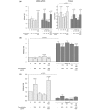Chondroitin and glucosamine sulfate in combination decrease the pro-resorptive properties of human osteoarthritis subchondral bone osteoblasts: a basic science study
- PMID: 17996099
- PMCID: PMC2246236
- DOI: 10.1186/ar2325
Chondroitin and glucosamine sulfate in combination decrease the pro-resorptive properties of human osteoarthritis subchondral bone osteoblasts: a basic science study
Abstract
Early in the pathological process of osteoarthritis (OA), subchondral bone remodelling, which is related to altered osteoblast metabolism, takes place. In the present study, we explored in human OA subchondral bone whether chondroitin sulfate (CS), glucosamine sulfate (GS), or both together affect the major bone biomarkers, osteoprotegerin (OPG), receptor activator of nuclear factor-kappa B ligand (RANKL), and the pro-resorptive activity of OA osteoblasts. The effect of CS (200 mug/mL), GS (50 and 200 mug/mL), or both together on human OA subchondral bone osteoblasts, in the presence or absence of 1,25(OH)2D3 (vitamin D3) (50 nM), was determined on the bone biomarkers alkaline phosphatase and osteocalcin, on the expression (mRNA) and production (enzyme-linked immunosorbent assay) of bone remodelling factors OPG and RANKL, and on the pro-resorptive activity of these cells. For the latter experiments, human OA osteoblasts were incubated with differentiated peripheral blood mononuclear cells on a sub-micron synthetic calcium phosphate thin film. Data showed that CS and GS affected neither basal nor vitamin D3-induced alkaline phosphatase or osteocalcin release. Interestingly, OPG expression and production under basal conditions or vitamin D3 treatment were upregulated by CS and by both CS and GS incubated together. Under basal conditions, RANKL expression was significantly reduced by CS and by both drugs incubated together. Under vitamin D3, these drugs also showed a decrease in RANKL level, which, however, did not reach statistical significance. Importantly, under basal conditions, CS and both compounds combined significantly upregulated the expression ratio of OPG/RANKL. Vitamin D3 decreased this ratio, and GS further decreased it. Both drugs reduced the resorption activity, and statistical significance was reached for GS and when CS and GS were incubated together. Our data indicate that CS and GS do not overly affect cell integrity or bone biomarkers. Yet CS and both compounds together increase the expression ratio of OPG/RANKL, suggesting a positive effect on OA subchondral bone structural changes. This was confirmed by the decreased resorptive activity for the combination of CS and GS. These data are of major significance and may help to explain how these two drugs exert a positive effect on OA pathophysiology.
Figures



Similar articles
-
The differential expression of osteoprotegerin (OPG) and receptor activator of nuclear factor kappaB ligand (RANKL) in human osteoarthritic subchondral bone osteoblasts is an indicator of the metabolic state of these disease cells.Clin Exp Rheumatol. 2008 Mar-Apr;26(2):295-304. Clin Exp Rheumatol. 2008. PMID: 18565252 Free PMC article.
-
Strontium ranelate inhibits key factors affecting bone remodeling in human osteoarthritic subchondral bone osteoblasts.Bone. 2011 Sep;49(3):559-67. doi: 10.1016/j.bone.2011.06.005. Epub 2011 Jun 12. Bone. 2011. PMID: 21700005
-
RANKL/OPG ratio and DKK-1 expression in primary osteoblastic cultures from osteoarthritic and osteoporotic subjects.J Rheumatol. 2013 May;40(5):684-94. doi: 10.3899/jrheum.120845. Epub 2013 Mar 1. J Rheumatol. 2013. PMID: 23457386
-
New perspective in osteoarthritis: the OPG and RANKL system as a potential therapeutic target?Keio J Med. 2009 Mar;58(1):29-40. doi: 10.2302/kjm.58.29. Keio J Med. 2009. PMID: 19398882 Review.
-
[Osteoclastogenesis and bone resorption].Nihon Rinsho. 2009 May;67(5):889-96. Nihon Rinsho. 2009. PMID: 19432105 Review. Japanese.
Cited by
-
Human osteoclasts/osteoblasts 3D dynamic co‑culture system to study the beneficial effects of glucosamine on bone microenvironment.Int J Mol Med. 2021 Apr;47(4):57. doi: 10.3892/ijmm.2021.4890. Epub 2021 Feb 19. Int J Mol Med. 2021. PMID: 33604678 Free PMC article.
-
Chondroitin sulphate: a focus on osteoarthritis.Glycoconj J. 2016 Oct;33(5):693-705. doi: 10.1007/s10719-016-9665-3. Epub 2016 May 19. Glycoconj J. 2016. PMID: 27194526 Review.
-
Intra-articular delivery of glucosamine for treatment of experimental osteoarthritis created by a medial meniscectomy in a rat model.J Orthop Res. 2014 Feb;32(2):302-9. doi: 10.1002/jor.22445. Epub 2013 Nov 5. J Orthop Res. 2014. PMID: 24600703 Free PMC article.
-
Levels of serum biomarkers from a two-year multicentre trial are associated with treatment response on knee osteoarthritis cartilage loss as assessed by magnetic resonance imaging: an exploratory study.Arthritis Res Ther. 2017 Jul 20;19(1):169. doi: 10.1186/s13075-017-1377-y. Arthritis Res Ther. 2017. PMID: 28728606 Free PMC article. Clinical Trial.
-
Effects of corticosteroids and their combinations with hyaluronanon on the biochemical properties of porcine cartilage explants.BMC Vet Res. 2015 Dec 4;11:298. doi: 10.1186/s12917-015-0611-6. BMC Vet Res. 2015. PMID: 26637428 Free PMC article.
References
-
- Martel-Pelletier J, Lajeunesse D, Pelletier JP. Etiopathogenesis of osteoarthritis. In: Koopman WJ, Moreland LW, editor. Arthritis and Allied Conditions: A Textbook of Rheumatology. Baltimore: Lippincott, Williams Wilkins; 2005. pp. 2199–2226.
Publication types
MeSH terms
Substances
LinkOut - more resources
Full Text Sources
Medical

